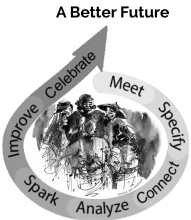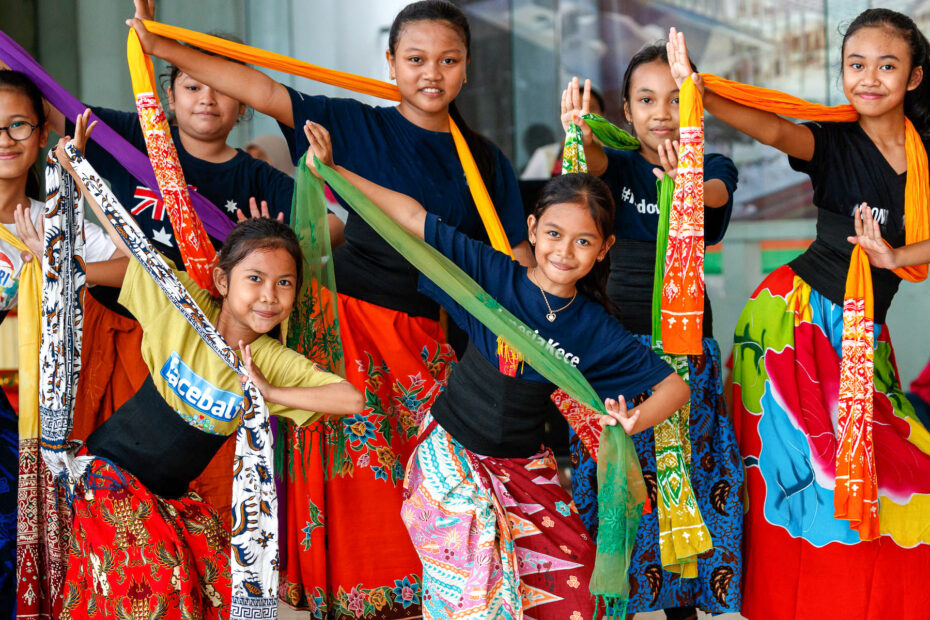Communication is happening all the time, all over the world, and it’s not just limited to spoken language. We connect with other people through the arts such as song, dance, stories, movement, and a variety of other media. The arts are a powerful way to communicate important messages that often go beyond words to speak more deeply to the heart. Unfortunately, all too often outsiders have neglected or, even worse, rejected local culture and arts outright as valuable methods of communication. Misunderstanding has resulted either in outright rejection or in misuse of these expressive forms. In the field of EthnoArts, we believe that communities have unique cultural gifts and artistic expressions that are an integral part of their identity.
All communities (including our own) struggle with challenges brought about by a rapidly globalizing and changing world. There is often a breakdown of cultural transmission between generations, or a loss of identity (cultural, communal, or spiritual). Communities struggle to adapt and find relevant, meaningful methods for communicating truth. Challenges can be even more difficult where there is trauma from war, disease, or abuse. In EthnoArts we believe that every community has appropriate communication methods to address these problems, but many are unused and neglected.
EthnoArts practitioners come alongside local artists to work towards a better future. The participatory process of learning and exploring together draws on insights from applied ethnomusicology, anthropology, community development, participatory methods, Scripture engagement, and more. Relationships are key: getting to know local artists is a first step which allows EthnoArts workers to enter respectfully into a community’s creative life.
EthnoArts is built on an important principle, one that has also been covered in a few EMDC.online sessions: we aren’t the experts, but rather we seek to ask good, open questions and draw out a community’s arts and cultural knowledge to walk alongside them in the journey towards discovering and using their gifts for a better future – be that scripture engagement, community development, ministry, health, education, or any other number of other things.
Many ministries and organizations view the arts as simply a container – find an interesting local artistic form, swap out the content for an important message, and then share it. This unfortunate assumption neglects the deeper cultural significance of the arts in culture and the crucial role of the community in creating their own artistic expressions. Rather than outsiders doing the creating, we see great power and importance in communities taking ownership of the research, the process, the decisions and goals, and the end results.
Our approach to development through the arts can be summarized as a series of seven steps, a method Brian Schrag created and calls Creating Local Arts Together (CLAT). The SIL EthnoArts website describes it this way:

- Meet a Community and Its Artistic Genres. Explore artistic and social resources that exist in the community. Performing Step 1 allows you to build relationships, involve and understand the people, and to discover the hidden treasures of the community.
- Specify Goals. Discover the goals that the community wants to work toward. Performing Step 2 ensures that you are helping the community work toward aims that they have agreed on together.
- Connect Genres to Goals. Choose an artistic genre that can help the community meet its goals, and activities that can result in purposeful creativity in this genre. Performing Step 3 reveals the mechanisms that relate certain kinds of artistic activity to its effects, so that the activities you perform have a high chance of succeeding.
-
-
-
-
- Analyze Genres and Events. Describe the event and its genre(s) as a whole, and its artistic forms as arts and in relationship to broader cultural context. Performing Step 4 results in detailed knowledge of the art forms that is crucial to sparking creativity, improving what is produced, and integrating it into the community.
-
-
-
-
-
-
-
- Spark Creativity. Implement activities the community has chosen to spark creativity within the genre they have chosen. Performing Step 5 actually produces new artistic works for events.
-
-
-
-
-
-
-
- Improve Results. Evaluate results of the sparking activities and make them better. Performing Step 6 makes sure that the new artistry exhibits the aesthetic qualities, produces the impacts, and communicates the intended messages at a level of quality appropriate to its purposes.
- Celebrate and Integrate for Continuity. Plan and implement ways that this new kind of creativity can continue into the future. Identify more contexts where the new and old arts can be displayed and performed. Performing Step 7 makes it more likely that a community will keep making its arts in ways that produce good effects long into the future.
-
-
-
These steps provide a general outline, but on-the-ground realities never work out as neatly as this 7-step process. It’s quite frequent that communities and EthnoArts workers may circle back and revisit steps multiple times, or even skip a step and return to it later. These steps are helpful reminders not to skip past important parts of the process, but we also recognize the messiness of the real-world application of these ideas.
Dr. Roberta King, in her book Global Arts and Christian Witness, writes:
We need to acknowledge that music and the arts offer dialogical ways of encountering and engaging with diverse peoples in Christ-centered witness…Shifting our focus from art products to the processes of creating art and music provides stepping-stones for forging relational bonds that engender pivotal moments, ultimately demonstrating Christ’s love—in us and for all peoples. (emphasis mine)
The arts are a dialogue, a relationship. In the world of media, it is easy to become overly focused on products – making them in the right style, giving them the right flavor, making them contextual. Dr. King reminds us that the process is just as important, if not more so, than the final product. The relationships we build with artists and communities are valuable and important. The CLAT process described above is also relational: this is not something an outsider does on their own to uncover some mysterious special key to unlocking effective communication, but rather it is a relational process of knowing and being known – transformation happens in that space.
Not everyone will become a full-time EthnoArts worker, but all of us can benefit from the insights gained in this field. Whether you are building websites, making media products, recording audio, or creating apps, EthnoArts wants to help you ask better questions and engage more deeply with the artistic life of a community in order to better understand and engage with local artistic traditions – all so that we communicate important and life-changing messages more clearly.
For further information about EthnoArts you can check out the Creating Local Arts Together manual or contact the authors of this post, Matt and Justin.

Matt was one of the guests on The EMDC Podcast in two episodes in which we learned more about ethnoarts. Be sure to check out our blog to watch or listen to episodes 11 & 12 at https://www.youtube.com/channel/UCJJmus6Dv0wd9Ano6-pwMLw or audio-only at https://anchor.fm/emdclive